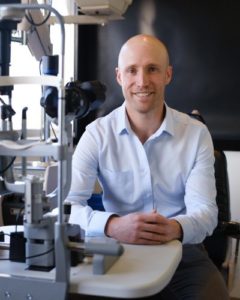
Digital media has enveloped nearly every area of our lives from billboards to our car’s on-board entertainment system. Here’s how to protect your eyesight.
Dr Morgan Hayes talks us through the stress our eyes take when we sit behind a screen all day, every day… and it’s not a pretty sight.
Our modern visual environment includes digital media in nearly every area of our lives from billboards to our car’s on-board entertainment system. Dr Morgan Hayes, an ophthalmic surgeon at Busamed Lowveld Private Hospital, says the level of strain on our eyes when we sit behind a screen all day, every day is not a pretty sight.
“We are increasingly seeing patients with a condition called ‘computer vision syndrome’ that is caused by reading and viewing content off a digital screen. Engaging in this activity is completely different from reading printed material, where, the letters on a screen are not as precise and sharply defined when compared to printed reading material. The level of contrast is also largely different and there is the issue of glare to contend with.” He says this ‘digital eye strain’ also alters our eye’s natural blink mechanism which carries negative ripple effects on the overall health of our eyes.
Dr. Hayes says staring at a screen all day impacts your natural blink-rate, slowing it down which leads to increased tear evaporation. This exacerbates dry eye disease. He says watery, red eyes, might seem contrary to dry eye disease, but watery eyes are a hyper response by the body to moisten your eye because it is so severely dry.
“It’s something that we are treating more often, because while you are concentrating or looking at an object (or screen) for a prolonged period of time, you don’t blink as often. Sometimes your eye opens wider causing an increase in surface evaporation and the body tries to counter this by increasing tear production to compensate for what moisture has been lost.”
Interestingly, the use of digital handheld devices (like a smartphone or tablet) has led researchers to discover that myopia (a condition which results in near-sightedness) is further enabled because the eye becomes accustomed to viewing objects that are only a few centimetres away from the face. “What is really interesting with myopia is that it is not only due to genetic factors, but various environmental factors too.”
Dr. Hayes says myopia is correlated to lifestyle (such as those with excessive use of digital devices) and socio-economic status. “Research shows that children living predominantly in urban environments have got a much higher risk of developing myopia compared to children of similar backgrounds, living in rural environments.”
The imbalance between near and far sighted work increases the risk of myopia. Understandably so, in that most of our work contains elements that require digital participation. “In near-vision work, we see heavy emphasis on reading books, for example, and using phones and tablets. Dr. Hayes’ advice is to employ the 20-20-20 rule which is to view an object 20 feet away, for 20 seconds, every 20 minutes. “With moderation and great respect for exposure protection, we should also venture outdoors to broaden the activity our eyes engage in.”
He says eye and skin protection is vital when going outdoors as UV rays are harmful to both organs. Regular eye examinations and proper viewing habits can help to prevent or reduce the development of the symptoms associated with computer vision syndrome. “If you’re not sure what the condition of your eyes are, getting a test will help you protect one of the most important assets you have,” he says.

Dr. Morgan Hayes
You may also be interested in:

April 3, 2024
Understanding Autism

March 27, 2024


